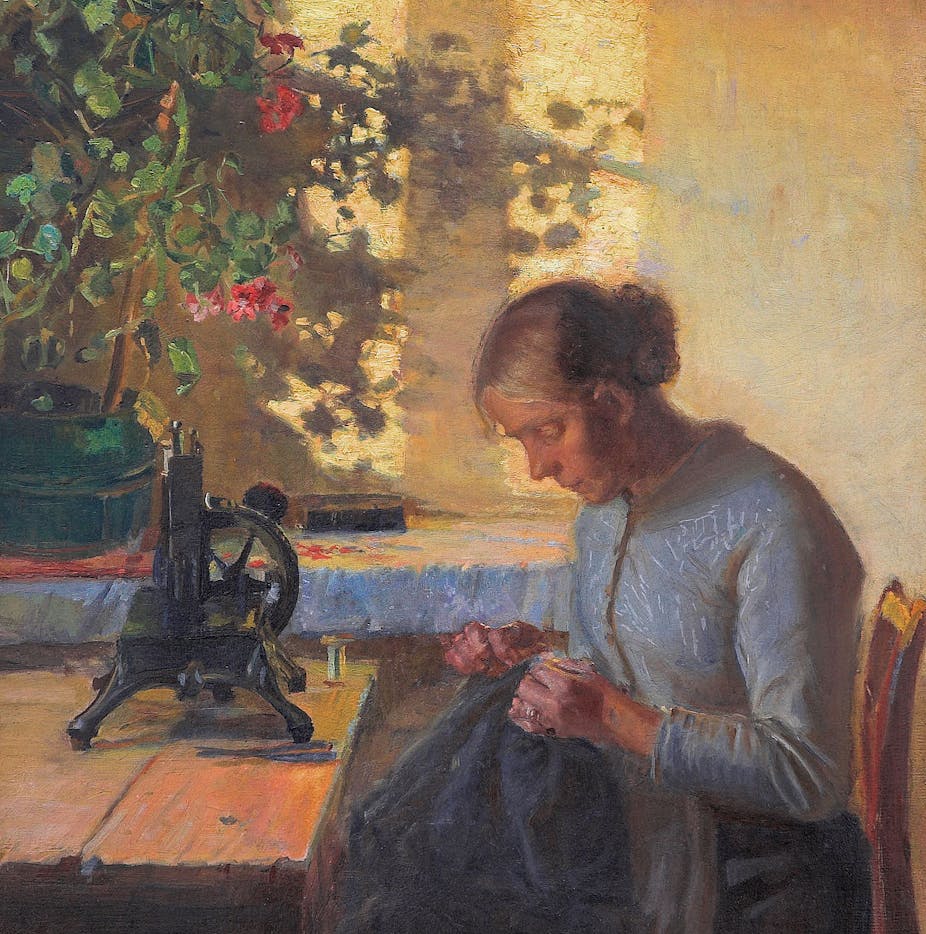The Great British Sewing Bee is back. The BBC reality show sees 12 amateur sewers compete in increasingly difficult stitching challenges, all hoping to be crowned the Sewing Bee champion. Now in its ninth series, the backstories of this year’s contestants show how sewing often provides an intimate, material connection to mothers and grandmothers.
For 49-year-old contestant Lizzie, sewing has been a way to “stay connected” to her mother, who taught her to sew. For Matthew, 30, it’s a reminder of his nan, who was a tailor. Her tailoring certificate hangs above his sewing space.

These stories are not surprising given the history of domestic needlework. Novelist Virginia Woolf (1882-1941) included details of home sewing and other stitching in her novels, as a fundamental part of her female characters’ everyday experiences.
While her sewing skills might not have been up to competing in The Great British Sewing Bee, I’m sure she would have been an avid viewer. Woolf’s writing illuminates the special place that sewing held in British households from the late 19th century.
Sewing machines became commonplace household items from the end of the 19th century. Needlework was a daily part of woman’s domestic labour.

Houses were full of the paraphernalia and activity of sewing. This image (left), from the first issue of Woman’s Weekly in 1911, shows “needlework in the afternoon” as part of “woman’s work”.
Woolf’s novels evoke this everyday activity with the heightened power of her modernist writing to reveal the metaphorical meanings of stitching.
Examples from three of her novels show how powerful the modern connection still is to an activity that in the 20th century was a required domestic duty but which, by the end of the century, most women had escaped.
1. The Years
The Years (1937) tells the story of the Pargiter family. In a historical sweep from 1880 through to the early 1930s, Woolf shows the changes wrought on women’s lives, including first-wave feminism and upheavals in social class.
Rose, the youngest Pargiter daughter, is a child in 1880. In one chapter her nanny, “looking up from the wheel of the sewing machine”, tells Rose: “Go and get your sewing, there’s a good girl.”

The nanny is preparing the child for traditional feminine domesticity. By 1910, the adult Rose doesn’t sew. She is a suffragette. Her cousin Maggie does, however, as strained financial circumstances mean that she cannot rely on servants. Woolf depicts Maggie making herself an evening dress, articulating the disparities in feminine identity at this revolutionary time for women.
Rose bemoans her lack of sewing ability: “I never could make my own clothes.” Maggie responds, “you did other things”. The two women share a moment of domestic intimacy as Maggie makes her dress with “a comfortable whirring sound as the needle picked through the silk”.
Even though she has abandoned needlework, Rose’s connection to the women in her family is imagined through the familiarity and comfort of sewing.
2. Mrs Dalloway
Mrs Dalloway (1925) evokes the intensity of a single day in the life of protagonist Clarissa Dalloway.
In the aftermath of the first world war, she is readying herself for a party at her home. An upper-middle class woman, Dalloway is impacted by the servant crisis of this period, so mends her own dress. In doing so, she returns to the forgotten rhythms of sewing from her childhood. Sewing becomes a deeply meditative activity:
Quiet descended on her, calm, content, as her needle, drawing the silk smoothly to its gentle pause, collected the green folds together and attached them, very lightly, to the belt.
This captures the strange nature of sewing. Like the “needlework in the afternoon” from Woman’s Weekly, it is work but also a “gentle pause” from pressing daily activities.
This is echoed in the way sewing is thought about by contestants on and viewers of The Great British Sewing Bee – with affection and nostalgia. It takes them back to a time spent with mothers, grandmothers and other female relatives in comforting and restorative activity.
3. The Waves
The Waves (1931) invokes the heightened place of sewing in a child’s psychic attachment to early maternal comfort. In the final section of the novel the adult narrator, Bernard, is searching for a language to answer life’s existential questions.

One image that comes to him is taken from deep childhood memory: “I need … words of one syllable such as children speak when they come into a room and find their mother sewing and pick up some scrap of bright wool, a feather, or a shred of chintz.”
Woolf and The Great British Sewing Bee remind us of very recent history when sewing was a daily household activity for most women. But this is not simply nostalgic.
The Great British Sewing Bee highlights the skills, pleasures and frustrations of sewing, which most of us don’t see any more, as our clothes are made in factories far away by people we will never meet. By understanding the intimacy of sewing we can imagine clothes makers as skilled human beings and realise our global stitching connections.

